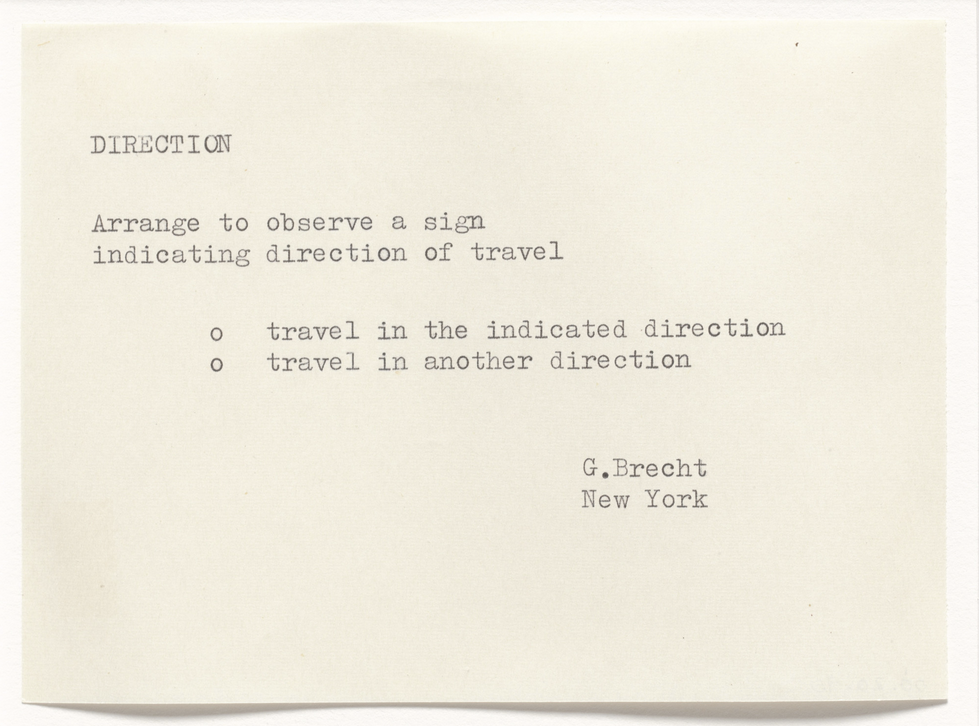
George Brecht, Direction (1962) – credit

George Brecht, Direction (1962) – credit
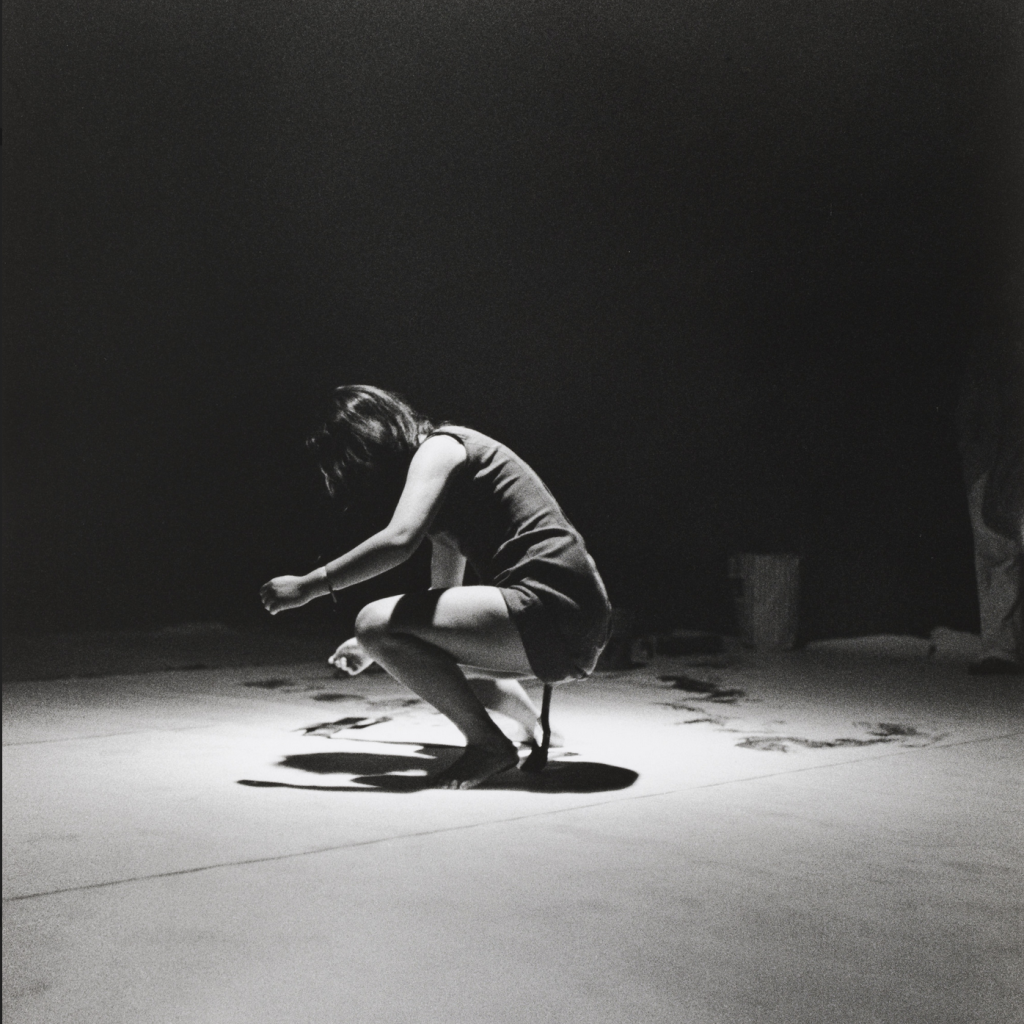
Shigeko Kubota Vagina Painting, performed during Perpetual Fluxfest, Cinematheque, New York, July 4, 1965
Shigeko Kubota (1937-2015)
“Born in 1937 in Niigata, Japan, Shigeko Kubota became a key member of the Japanese avant-garde, a respected participant in New York Fluxus events in the 1960s, and, starting in the 1970s, a pioneering practitioner of video art. Upon graduating from the Tokyo University of Education in 1960, she fell in with members of the avant-garde movements Group Ongaku, Hi Red Center, and Zero Jigen. These groups pushed art’s boundaries, incorporating music, performance, and movement into their work, with which they questioned the centralized authority of the postwar Japanese government and what they viewed as its focus on economic growth at the expense of the well being of individual citizens. Their experiments were also in keeping with the activities of Fluxus artists like George Maciunas and John Cage, whose works were highly regarded by the Tokyo avant-garde. Fluxus was an international, interdisciplinary movement that promoted experimentation across mediums, and a number of Japanese artists became important members, including Ay-O, Takako Saito, Yoko Ono, and Mieko Shiomi (who moved to New York with Kubota in 1964).
Because critics in Japan ignored most avant-garde art, and were particularly dismissive of women artists, Kubota decided that she would have better career opportunities in New York, where she was immediately accepted into the Fluxus community. Maciunas dubbed her the “vice president of Fluxus” for helping him to organize events and distribute mail art, and for her active participation in activities including the “Fluxus dinner commune”—a short-lived series of communal dinners prepared and attended by Fluxus artists, who would conclude the meals by making objects—and the production of multiples, small, multi-editioned works that were frequently produced collaboratively. Kubota also produced some of her own Fluxus objects, including Flux Napkins (c. 1967) and Flux Medicine (c. 1966).
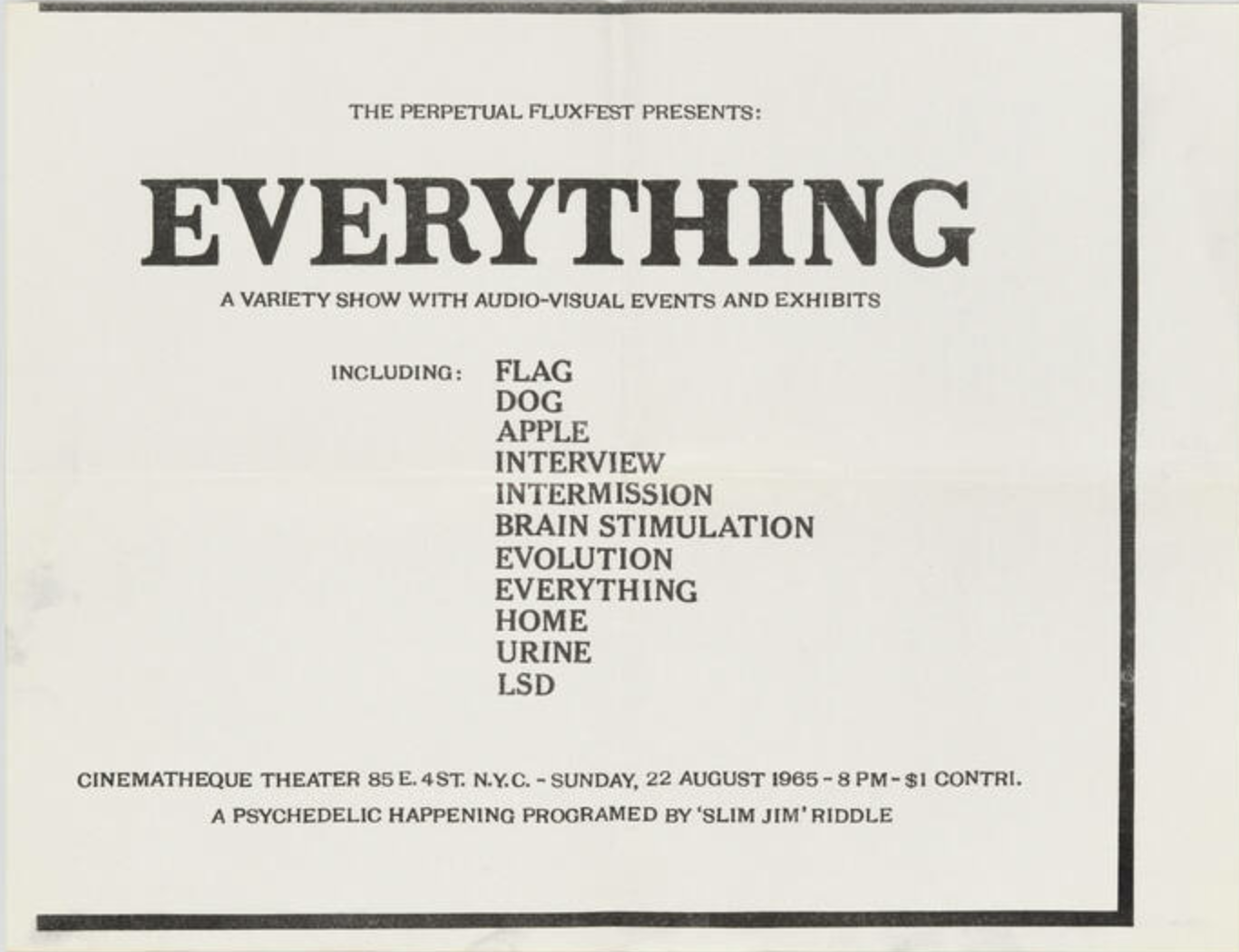
James Riddle, Fluxus, “THE PERPETUAL FLUXFEST PRESENTS: EVERYTHING” (1965) [credit]
Following Vagina Painting, Kubota turned away from performance and began exploring new media, particularly video, which would comprise the bulk of her output for the rest of her career. Duchampiana: Nude Descending a Staircase (1976)—which features three video monitors embedded in a plywood staircase showing a nude woman walking down stairs—reveals her indebtedness to Marcel Duchamp. This was the first video sculpture acquired by MoMA. Kubota and her husband, Nam June Paik, pioneered the development of video art, exploring the aesthetic, technological, emotive, and even organic potential of this new medium.” [credit]

Takehisa Kosugi (1938-2018)
” “Keep walking intently.” That straightforward instruction formed the entire score for Takehisa Kosugi’s Theatre Music. … Theatre Music was one of a series of the Japanese artist’s “Event” pieces, printed on a set of cards and published in 1964 by George Maciunas, founder of the Fluxus movement.” [credit]
“The most generically titled of his Fluxus scores, Theater Music, is deceptive in its indeterminacy and formulation. Patently without object, and strikingly unmusical, it simply instructs: “Keep walking intently.” It is worth pausing to consider this. The piece brings focus, even determination to a daily action. Calling on the impetus of the individual or the collective, there is the fundamental element of endurance, an intensity in commonality, compressed within the borders of its time; space is thickened by a threat of the interminable. The otherwise quotidian activity of walking is framed as out of the ordinary by the “theater” of its execution. And through its accessibility, like the simplest Fluxus works, including others by Kosugi, it has continued to take on meaning through unlikely executions.” [credit]
Takehisa Kosugi
Theatre Music
New York City, USA: Fluxus, 1963
card: 5.5 x 11 cm., foldout: various sizes
Edition size unknown
Most copies of Fluxus 1 contained both the score card for Theatre Music (“Keep Walking Intently”) and the realization of the work: footprints on paper. The card also appears in Kosugi’s boxed work Events, and is reproduced in the second Fluxus newspaper.
The George Maciunas designed graphic of seventy-three boots in a spiral pattern is among his more iconic images.
A recent book on walking in the arts takes its title from the Kosugi work: Keep Walking Intently: The Ambulatory Art of the Surrealists, the Situationist International, and Fluxus, by Lori Waxman (2017).
The Fluxus 1 realization of the composition is similar to Yoko Ono’s Painting to Be Stepped On.
“In Theatre Music the performer is concerned with a simple unity of time, space and bodily movement. The persistence (“Keep”, “Intently”) takes on a savagely physical character in Music for a Revolution: “Scoop out one of your eyes five years from and do the same with the other eye five years later”.”– Michael Nyman, Experimental Music: Cage and Beyond
[credit]
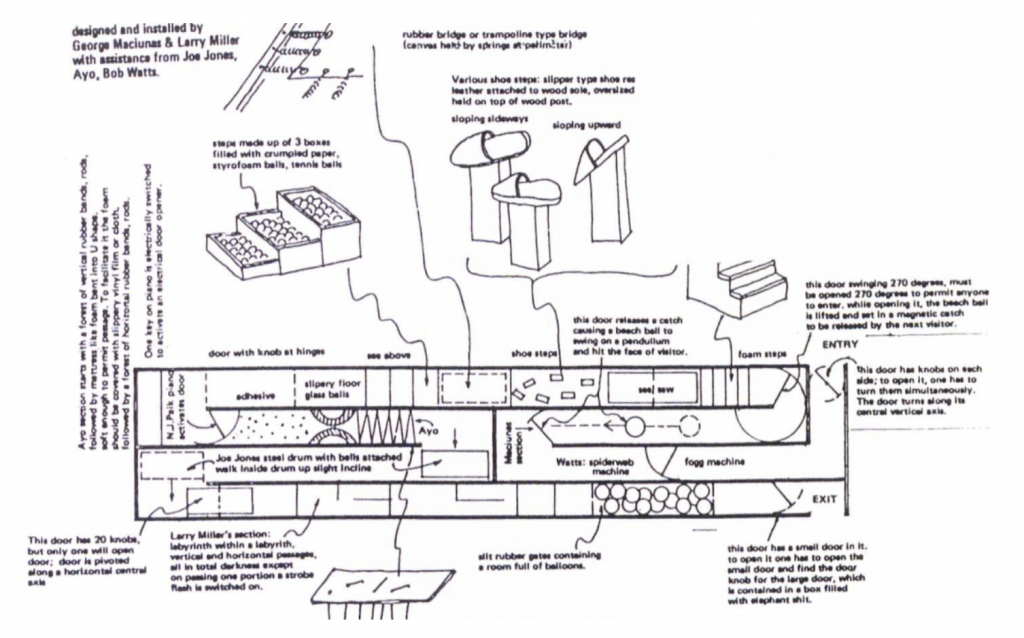
Read a full account of the Flux-Layrinth from initial plans in SoHo NYC, to the first execution in Berlin, and later a 2015 installation in NYC. [read more – includes images and plans]
“As Fluxus founder George Maciunas often referred to, Fluxus is gag-like, and Fluxus artists are jokers. Fluxus artists have been producing not good art per se, but inventive gags, among which this one hundred square meters Flux-Labyrinth (1975-1976) was a notable one. This was a collective efforts by Fluxus artists including George Maciunas, Larry Miller, Ay-O, Joe Jones, Bob Watts, Ben Vautier, George Brecht, Geoff Hendricks and many others. This project not only marked the particular organizational and collaborative genius of George Maciunas, but also perfectly illustrated his interpretation of Fluxus through a well-designed life-sized gag.
According to George Maciunas, the whole structure of gag is linear and monomorphic, just like Fluxus’ conceptual inventions. There are sight gags, sound gags, object gags, all kinds of gags. But no joke can be presented in multi-forms, nor can several jokes be made simultaneously, because people just cannot get it at once. Likewise, the Flux-Labyrinth is a cleverly designed and rigidly defined gag series, which unfolded linearly in the obstacle-laden one-way passage among extensive maze of puzzling.
In Maciunas’ letter to René Block, explaining the final plan of labyrinth with great detail, he wrote, “First door at entry is one with a small (about 10cm square) door with its own knob. One has to open it and find pass the hand through, looking for the knob of the big door on other side that will open door. This way only smart people will be able to enter. Anyone passing that door will be able to pass all obstacles. Idiot will be prevented from entering…”
The opening statement is clear, it is an intelligent game. As described by Larry Miller, “Part fun house and part game arcade, the labyrinth fits within Maciunas’ broader idea of Fluxus-Art-Amusement.” Fluxus, at least Mr. Fluxus, is a serious joker.” [credit]
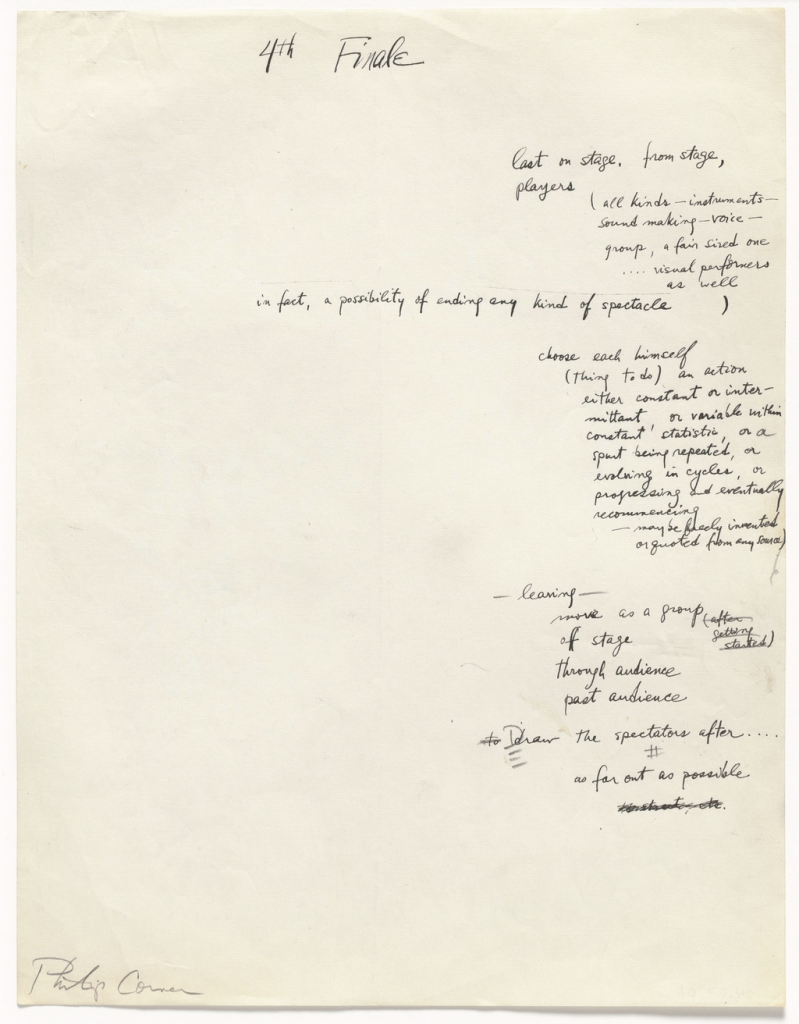
Philip Corner, “4th Finale” (1962)
Score: “Members of a marching band, each playing to their own tune, leave the stage and whatever building they are in, followed by the audience.”
Credit: Waxman, Lori. Keep Walking Intently: The Ambulatory Art of the Surrealists, the Situationist International, and Fluxus. Sternberg Press, 2017. Page 266.
“4th finale was performed by Lynghøj School Brass Band at Stændertorvet. Each performer was instructed to choose an action to perform, whether this was constant, intermittent or variable was up to the performer himself. The tune or sound could consist of a repetition, a cyclic progression or an evolving note, and could be freely invented or quoted from any source.
The performers were instructed to continue their chosen sound, while slowly beginning to leave the area. As the orchestra left Stændertorvet, spectators followed in procession down the street towards the Viking Ship Museum.” [credit]
[credit]
“Costume by Eric Andersen
Performed by The Group Berzerk
During the art fair Art in 1980 in New York, Gallery Interart from Washington arranged a sensational Fluxus Buffet from October 10 through 18, 1980. The following artists participated: Eric Andersen, George Brecht, Joe Jones, La Monte Young, Yasunao Tone, Nam June Paik, Takako Saito, Mieko Shiomi, Daniel Spoerri, Emmett Williams, AY-O, Geoff Hendricks, Dick Higgins, Alison Knowles, Yoshimasa Wada and Bob Watts. For the occasion Eric Andersen produced a Dinner Dress for 30 people. The costume is part of a series of possible shared costumes for which function overrules convention. Among these costumes are a TV Costume for 1 to 10 people, a Soccer Costume for 11 people, an Industry Costume for 5 to 10,000 people, a Big City Costume for 5 to 10 million people, an Erotic Costume for 3 to 99 people, a Witness/Victim Costume for more than 2 people and a Debate Costume for fewer than 179 people.
In 1984 in Copenhagen, the group Berzerk performed The Idle Walk of the Year for Eric Andersen – a procession stretching from The Ethnographic Collection at The National Museum through The National Bank to the courtyard of Amalienborg Castle. During the Festival of Fantastics, Berzerk performed with the 30 people costume carrying out an extensive choreography. Initially, the performers put on every second part of the costume, conducting a procession across Stændertorvet. Then audience members were invited to enter the remaining fifteen costume parts. The ensuing procession climbed ladders on fire department vehicles and stretched through city streets, alleys, busses and shops. The whole performance lasted more than two hours.
Eric Andersen’s description of The MassDress“
[credit]
Copenhagen, Denmark: “At The Idle walk of the Year, the 29 th August 1984 he invited the Anarchistic drama group Berserk, and instructed them to carry a variety of objects from the museum to Amalienborg Square while walking as slowly as possible without standing still. As a result all traffic in central Copenhagen came to a stand still for six hours. Eric describes:
“The police was completely in on it. You could see a motorcycle police officer wearing a Year of the Idle badge on his chest pocket while driving his bike as slowly as he could through the city. Nothing at all happened that required their attention throughout those hours, so of course they were happy.”
Eric himself polished the Palace Square using Petroleum, like the Ethnological Museum had done to their wooden floors since the nineteenth century. A tradition Eric found so fascinating that hebrought it to the Palace Square.”
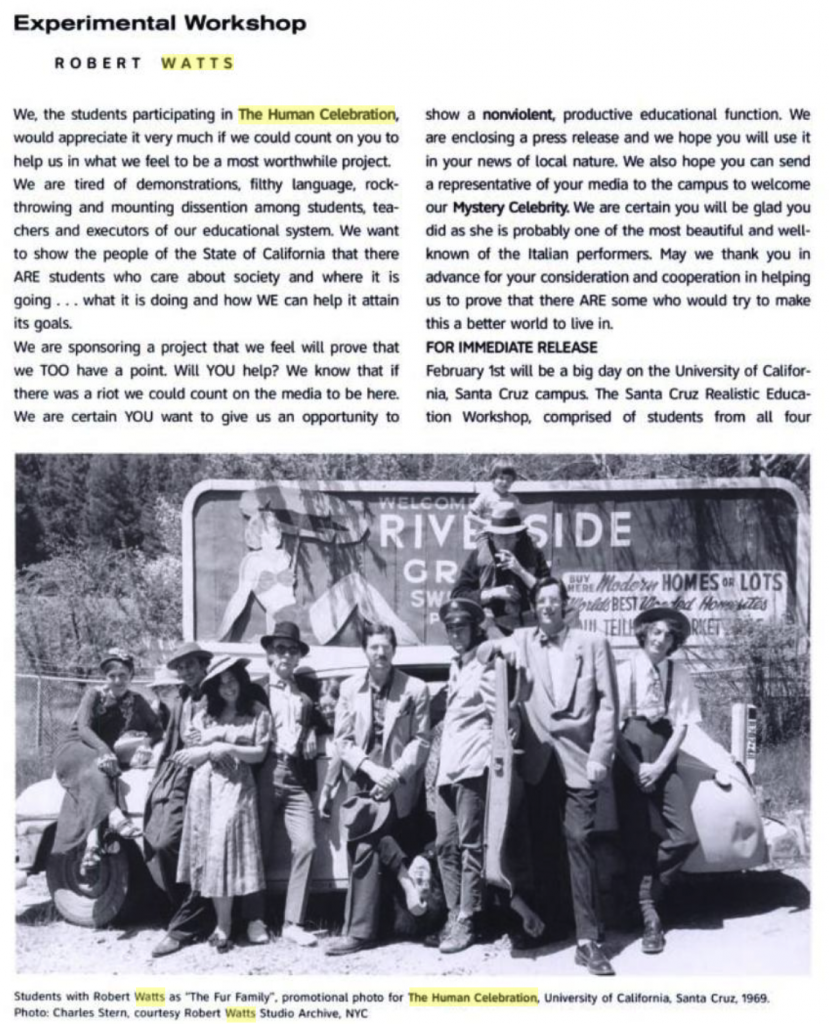
Credit: Hendricks, Geoffrey. Critical Mass: Happenings, Fluxus, Performance, Intermedia and Rutgers University 1958-1972. Rutgers University Press (2003).
“The film combines men and women almost equally, capturing their exposed buttocks in a tight frame that results in quadrants of flesh, hence the “No. 4″ of the title. Since the telltale part of the human anatomy is facing away from the camera, the viewer is left to parse out identity based on subtle signs of difference, including hair, fat, and shape. Motion comes into play because the subjects are shot while walking, a fact that can be guessed by carefully watching the film and that is proved in a production still, which illustrates the simple rotating contraption on which they moved in place.”
Credit: Waxman, Lori. Keep Walking Intently: The Ambulatory Art of the Surrealists, the Situationist International, and Fluxus. Sternberg Press, 2017. Page 261.
This work was presented as a map of the midtown New York Public Library, with arrows showing the route to run, from the main entrance up to the third floor and out again.
Critic Lori Waxman compares this score to Robert Filliou’s One-Minute Scenario (1963), and points out how race and place deeply affect these scores. Filliou is a white French Protestant with a glass eye referencing a hotel, while Patterson is a Black man and references the library.
Credit: Waxman, Lori. Keep Walking Intently: The Ambulatory Art of the Surrealists, the Situationist International, and Fluxus. Sternberg Press, 2017. Page 232.